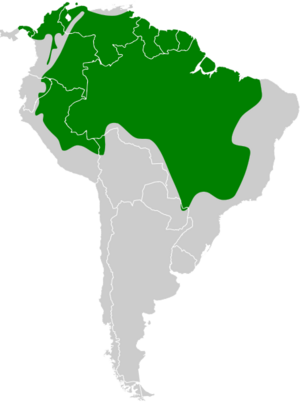Buff-breasted wren facts for kids
Quick facts for kids Buff-breasted wren |
|
|---|---|
 |
|
| at Boa Esperança do Sul, São Paulo State, Brazil | |
| Conservation status | |
| Scientific classification | |
| Genus: |
Cantorchilus
|
| Species: |
leucotis
|
 |
|
| Synonyms | |
|
Thryothorus leucotis |
|
The buff-breasted wren (Cantorchilus leucotis) is a small, active bird from the Troglodytidae family, also known as wrens. You can find this bird in many parts of South America. It lives in the Amazon Basin across countries like Brazil, Colombia, Ecuador, Peru, and Bolivia. It also calls home to Guyana, Suriname, French Guiana, Venezuela, and even eastern Panama.
Contents
What's in a Name?
Scientists group living things into families and species. This helps us understand how different animals are related. The buff-breasted wren belongs to the Cantorchilus group. There are 11 known types, or subspecies, of the buff-breasted wren. Scientists are still studying them to see if some might be their own separate species. It's like a big puzzle they are trying to solve!
What Does It Look Like?
Buff-breasted wrens are small birds. Males usually weigh about 18.5 to 22.8 grams. Females are a little lighter, weighing 16.0 to 19.5 grams. That's about the weight of a few paper clips! Both male and female wrens look quite similar.
Their feathers can vary a lot depending on where they live. Their head, back, and tail are usually a reddish-brown or grayish-brown color. Their tail often has dark stripes. The throat and face can be whitish, gray, or gray-brown. Their chest is a warm, buffy color, and their belly is more cinnamon-colored. Young wrens are usually duller in color than the adults.
Where Do They Live?
The buff-breasted wren lives mainly in northern and central South America. This includes the huge Amazon Basin. You can find them in most of Venezuela and northern Colombia. Their range even stretches into eastern Panama.
In the west, near the Andes mountains, they are found in eastern Peru. They also live in the very northwest parts of Bolivia. The bird's home also includes the Guianas (Guyana, Suriname, and French Guiana). You can even spot them on Ilha de Marajo, an island at the mouth of the Amazon River.
In Brazil, their range covers the central-southern and southeast Amazon Basin. It reaches almost to the Atlantic Ocean coast. They are mostly found in the southern Cerrado region. They might even live in parts of the nearby Pantanal.
What Kind of Places Do They Like?
Buff-breasted wrens live in many different places. They prefer areas with low to medium-height plants. You can find them in forests that are growing back after being cut down. They also like the edges of forests and clearings. Sometimes, they live in mangrove forests or coffee farms.
In Venezuela, they stick to forests along rivers in grassy areas. In the Amazon, they often live at the edges of várzea forest (forests that flood) and on old river islands. They have also been seen in untouched forests in Bolivia. One type of buff-breasted wren even lives in dry, scrubby areas in Colombia.
How Do They Behave?
What Do They Eat?
Buff-breasted wrens usually hunt for food in pairs or with their family. Sometimes, they even join groups of different bird species looking for food. They typically search for food between 1 and 6 meters (about 3 to 20 feet) above the ground. But they also look on the forest floor or as high as 18 meters (about 60 feet) up in trees!
They hop or fly short distances through thick plants. They pick insects, spiders, and other small bugs off leaves and branches. They also poke around to find hidden snacks.
How Do They Raise Their Young?
Buff-breasted wrens build two kinds of nests. One is for raising their babies, and the other is a "dormitory" nest for sleeping. Both nests are round and made of small sticks, grasses, and other tough plant parts.
The breeding nests are lined with softer materials inside. The dormitory nests are usually not as strong. Both types of nests have a tunnel-like entrance. The entrance to the breeding nest is often longer and points downwards. Both the male and female bird work together to build these nests. Young wrens might even help build the sleeping nests!
Most nests are built between 1 and 2 meters (about 3 to 6.5 feet) off the ground. However, some can be as high as 10 meters (about 33 feet). They build nests in trees, bushes, tangled vines, and palm trees. Usually, a female lays three eggs, but sometimes only two. Other birds, like shiny cowbirds and striped cuckoos, sometimes lay their eggs in the wren's nest for the wrens to raise.
What Do Their Songs Sound Like?
Both male and female buff-breasted wrens have many different songs. Often, the male will start a song, and the female will finish it. They also make a variety of calls to communicate with each other.
How Are They Doing?
The IUCN (International Union for Conservation of Nature) says the buff-breasted wren is a species of "Least Concern." This means they are not currently in danger of disappearing. The bird lives in a very large area and is thought to be common throughout its home range.


